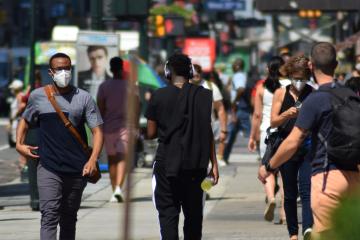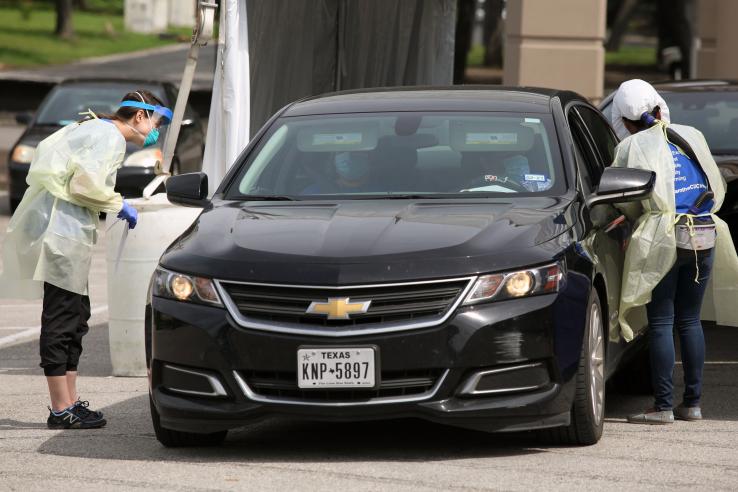
Building an effective COVID-19 response: Strategies to improve health care delivery and increase health equity

The COVID-19 pandemic has placed unprecedented strain on the American healthcare system, and in doing so has brought to light many of its most persistent shortcomings. Despite spending far more than any other country on healthcare, the United States has reported the highest number of coronavirus cases and the highest number of related deaths, causing many to question the underlying structures of the nation’s health care system. Gaps in health care access, coverage, and quality based on race, socioeconomic status, and geographic location are, in the midst of a global pandemic, rapidly widening and becoming more apparent than ever.
As nationwide protests against police violence and systemic racism continue across the United States, blatant disparities in COVID-19 infections and deaths point to the pressing need to address inequities in health and a myriad of other areas. Narrowing the significant socioeconomic gaps in health care access during the pandemic and post-pandemic context is an imperative undertaking.
Better understanding and addressing the social determinants of health is critical to improving individual and population health and advancing health equity; without taking an intersectional approach to addressing health, disparities will persist and communities will be left behind in the fight to mitigate the impact of COVID-19 and recover from the pandemic.
J-PAL North America’s COVID-19 Recovery and Resilience Initiative aims to contribute to knowledge in this area by testing strategies to minimize the short and long-term public health impacts of COVID-19 and address inequities in access and care. By teaching policymakers what programs and policies work to improve health equity and access, rigorous evidence can play a fundamental role in helping the nation respond effectively to COVID-19 while building a more equitable healthcare system in the long-run.
Pre-existing inequity in health care delivery and access
Communities of color have been hit the hardest by the COVID-19 pandemic, reflected in higher infection and death rates for Black, Hispanic, and Indigenous populations. These disparities in COVID-19 diagnoses and deaths are the result of pre-pandemic realities that have long limited access to health care and wealth. Structural factors—such as residential segregation and gentrification, workplace conditions, and economic security—have worked to reinforce and intensify health disparities by socioeconomic status, and contributed to rates of pre-existing health conditions that correlate with higher vulnerability to COVID-19.
Additionally, Black, Hispanic, and Indigenous communities in the United States often have less access to quality health care: even before the arrival of the novel coronavirus they were significantly more likely to be un- or under-insured. Immigrant communities are especially likely to be uninsured, as they are overrepresented in jobs that do not provide health insurance coverage, and undocumented individuals are explicitly barred from accessing most public and employer-sponsored plans.
There is also a history of distrust between these communities and the American health care system stemming from inaccessible care, disparities in health outcomes, a lack of Black, Hispanic and Indigenous physicians, and, for Black Americans, a longstanding history of medical exploitation and abuses dating to slavery.
Contact tracing, a public health tool that asks individuals to divulge personal, detailed information, inherently requires a degree of trust that our healthcare system has failed to earn from many communities of color. The combination of systemic distrust coupled with disparities in the quality of housing, jobs, and care available to communities of color has resulted in disastrous health outcomes for Black, Hispanic, and Indigenous communities during the COVID-19 crisis.
The impact of COVID-19
Amidst a global health crisis that has had catastrophic impacts on public health globally, the United States’ healthcare system has been hit particularly hard: the country has 4 percent of the world’s population, but about 24 percent of its COVID-19 cases and 22 percent of its COVID-19 deaths (as of September 1).
Overburdened hospitals serving the most hard-hit regions are struggling to pay for critical health services amidst rising equipment costs and declining revenues. They are also less able to provide quality primary care, mental health care, and care for chronic conditions in the struggle to funnel resources toward responding to COVID-19.
Deaths from noncommunicable diseases such as heart disease and diabetes have increased during the pandemic, possibly because individuals are afraid to seek emergency care out of fear of being exposed to the virus. On top of this, the United States is facing an unprecedented mental health crisis, with people experiencing higher rates of depression, anxiety, substance use, and suicidal ideation due to coping with the pandemic.
Nationally, Black and Hispanic populations have been disproportionately impacted by the virus, accounting for higher rates of infection and death than would be expected given their share of the national population. Of the 20 counties in the United States that have the highest level of COVID-19 deaths per capita, 11 counties have populations in which Black, Hispanic, or Indigenous people represent the largest racial group.
Adjusting for age, the coronavirus death rate for Hispanic populations is 2.5 that of white populations. For Black communities the numbers are even more harrowing, with Black populations dying at a rate of 3.6 times that of white populations. Part of the reason behind such disproportionate rates of infection and mortality stems from the fact that Black workers, Hispanic workers, immigrants, and women are disproportionately represented in essential, frontline jobs which dramatically increase one’s risk of exposure to the virus.
The economic impacts of the COVID-19 pandemic have had disastrous impacts on health inequities as well: the number of Americans living without health insurance has nearly doubled in size since late February, and families who have been financially impacted by the virus are struggling to pay for basic care. A disproportionate number of those losing employer-based coverage have been Black and Hispanic individuals. Without coverage, these families are likely to face more barriers to accessing quality care and may face significant negative health impacts as a result.
On top of this, the pandemic has negatively impacted families’ financial stability, which in turn has drastic implications for widening health disparities. As a result of job loss, financial shocks, and reduced income, a growing share of the population is struggling to afford nutritious food, access quality medical care, remain safe and stably housed, and pay for costs related to education—factors which serve as central determinants of health. As state moratoriums on evictions come to an end, an increase in the number of individuals experiencing homelessness and housing instability will leave more communities vulnerable to the virus, as well as vulnerable to long-term negative health outcomes.
Tenants of color are disproportionately impacted by evictions, and cities across the nation such as Boston, Los Angeles, and New York are preparing to see an increase in the rate of individuals experiencing homelessness among Black, Hispanic, and immigrant communities. Within this context, it is becoming more and more clear that addressing health disparities that stem from unequal social and economic conditions is of absolute necessity to fight and recover from COVID-19.
Research to improve health care delivery and expand health care access
The COVID-19 pandemic has already placed an indelible mark on nearly every aspect of the United States healthcare system. To deal with an unprecedented crisis, we need new research demonstrating what works to adapt our health care practices, programs, and policies to best respond to and recover from the pandemic as quickly and effectively as we can.
What are effective and equitable strategies to deliver quality health care given new constraints imposed by COVID-19?
Community health workers are frontline public health workers who are trusted members of the communities they serve. Better understanding how these workers can facilitate access to health, social, and community services in a pandemic setting may be a critical component in ameliorating the impact of COVID-19 on communities with specific health needs, such as Indigenous communities and other communities of color.
Additionally, in a time of social distancing, when many health care services are no longer provided in-person or in clinical settings, it is important to better understand how interventions such as telehealth can be used and adapted to meet the needs of different communities, especially those where health care access is limited.
How can health officials increase take-up of positive health behaviors?
The widespread adoption of positive health behaviors is necessary to minimize the spread of COVID-19. Researchers should work with public health authorities to identify ways to improve take-up of positive behaviors such as wearing a mask, avoiding unnecessary crowds, and, when it becomes possible, receiving the COVID-19 vaccine. Examples of interventions to increase take-up may include information campaigns, direct encouragement to take-up services, or increased access to free masks.
What can health care delivery organizations do to provide accessible and impactful mental health care?
In a period of increased social isolation, uncertainty, and financial stress, accessible and impactful mental health services are more critical than ever. Loneliness and social isolation are linked to poor health and mental health outcomes.
Due to the closure of clinics, provision of mental health services and counseling are more difficult for individuals to access, and for many, accessing counseling is cost-prohibitive. It is critical to have data on the efficacy of innovative strategies to deliver mental health care in this new context, including telehealth and app-based mental health services.
How can health officials address the unique health needs for those experiencing major barriers to health care, including those who are uninsured, incarcerated, or experiencing homelessness?
People without insurance in the United States often minimize their use of health care due to the high cost of seeking care, and may be hesitant to seek out critical COVID-19 testing or treatment. Further, individuals who are incarcerated and those experiencing homelessness represent two groups who are at high-risk of COVID-19 infection, lack access to adequate health care, and are unable to practice the positive health behaviors recommended to limit the spread of COVID-19.
Researchers should work with community agencies and health officials to identify effective ways to encourage the take up of health care for groups who largely lack access to care opportunities. Programs to broaden the reach of mental and physical health care service (such as mobile or telehealth platforms), increase trust in health systems and services, and connect individuals with social safety net programs may be important.
This post is an installation in J-PAL North America's "Building An Effective COVID-19 Response" research guide blog series. The complete series highlights the interaction between COVID-19, research, and the policy areas of health care delivery, jobs and the social safety net, and education.


